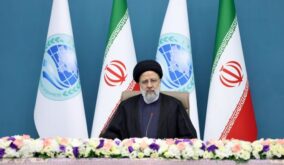VOA – An exiled Iranian Arab rights activist has revealed that three minority Arab dissidents executed by Iran’s Islamist authorities last month showed signs of torture before their death sentences were carried out.
In a Wednesday interview with VOA Persian from London, researcher Karim Dahimi said dissidents Jasem Heidary, Ali Khasraji and Hossein Silawi had bruises when relatives were given a brief chance to see the men shortly before their Feb. 28 executions at Sepidar prison in the southwestern city of Ahvaz. The rights activist cited information he got from the relatives, whom he did not name.
Dahimi has a reputation as a credible source on the human rights situation of his ethnic Ahwazi Arab minority group that lives mainly in Iran’s Khuzestan province, of which Ahvaz is the capital. His research is cited by international human rights organizations such as the Washington-based Abdorrahman Boroumand Center and the Oslo-based Iran Human Rights group.
Iranian state news agency Tasnim reported the Feb. 28 executions of Heidary, Khasraji, Silawi and a fourth Iranian Arab dissident, Naser Khafajian, at Ahvaz’s Sepidar prison in articles published on March 1. All four had been sentenced to death for alleged national security crimes after what international rights activists said were unfair trials based on confessions extracted under torture.
Dahimi said the prisoners’ relatives told him that Iranian authorities had transferred the four men to Sepidar prison earlier on Feb. 28. He said Heidary, Khasraji and Silawi previously had been held in Sheiban prison on the outskirts of Ahvaz, while Khafajian had been detained at a prison in the town of Dezful, a two-hour’s drive to the north.
The rights activist cited the relatives as saying Ahvaz authorities contacted them Feb. 28, instructing one family member of each of the four prisoners to gather at a city square in order to be taken to Sepidar prison to see their loved ones for a final time before execution. He said the relatives told him that authorities gave them only several minutes for the final meetings and then instructed them to stay at the prison for about an hour, after which the bodies of the four men were presented to the relatives in body bags for identification.
But instead of handing the dissidents’ bodies to the families for burial, Dahimi said the relatives told him that authorities buried them in unmarked graves in a section of Ahvaz’s Behesht Abaad cemetery where bodies of government opponents typically are interred after execution. He said the relatives also reported no death certificates being issued for their loved ones.
VOA cannot independently verify the circumstances of the executions and interments of the four Iranian Arab dissidents because it is barred from reporting inside Iran.
“Unfortunately, this has become a trend in recent years for Ahwazi Arab activists whose death sentences have been carried out,” Dahimi said. “Iran’s judiciary and security agencies use these discriminatory practices to suppress dissent and prevent people from staging protests.”
In a Feb. 12 statement urging people to call on Iran not to execute the four men, London-based rights group Amnesty International said Heidary, Khasraji and Silawi had been on a hunger strike since Jan. 23, sewing their lips together in protest of their prison conditions, denial of family visas and the threat of impending execution. It said Khafajian had been forcibly disappeared since April 2020.
Rights groups have said the four men were sentenced to death in two separate cases.
In one case, Khafajian, Khasraji and Silawi were arrested in May 2017 for alleged involvement in an armed attack that killed two officials at an Ahvaz police station that month. Shortly after their arrest, Iranian state TV broadcast what rights activist have said were the forced confessions of the three men.
In the other case, Heidary was arrested in November 2017 after returning to Iran from abroad and sentenced to death for alleged collaboration with armed opposition groups. Rights groups have said Heidary also was forced to make a confession.
In its March 2020 annual report on human rights in Iran, the State Department of former President Donald Trump said the predominantly Persian and Islamist-ruled nation’s estimated 2 million Ahwazi Arabs were among several minority groups “disproportionately targeted” by authorities for “arbitrary arrest, prolonged detention, disappearances and physical abuse.”
The report also said a widespread complaint among Ahwazis was that the Iranian government diverted and mismanaged natural resources, primarily water, often for the benefit of contractors affiliated with Iran’s most powerful military force, the Islamic Revolutionary Guard Corps (IRGC).
The Biden administration has not commented on the executions of the Iranian Arab dissidents.
In a Tuesday tweet, Secretary of State Antony Blinken said the U.S. has “made clear (its) concerns” about Iran’s human rights situation and will “continue to hold violators accountable.” He also announced U.S. sanctions on two IRGC officials for what he called “gross human rights violations” against anti-government protesters in 2019 and 2020.
Today, @UN_HRC we made clear our concerns about the #HumanRights situation in Iran. The United States will continue to hold violators accountable. Therefore, today I designated Ali Hemmatian and Masoud Safdari for gross human rights violations against protestors in 2019 and 2020.— Secretary Antony Blinken (@SecBlinken) March 9, 2021
This article originated in VOA’s Persian Service. Click here for the original Persian version of the story.
 Shabtabnews In this dark night, I have lost my way – Arise from a corner, oh you the star of guidance.
Shabtabnews In this dark night, I have lost my way – Arise from a corner, oh you the star of guidance.


